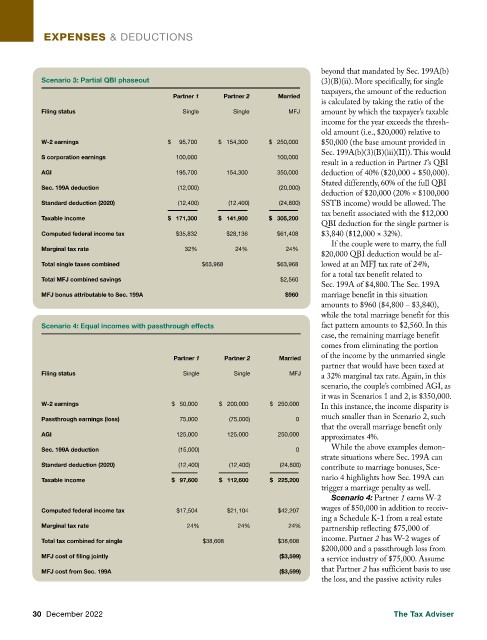Page 639 - TaxAdviser_2022
P. 639
EXPENSES & DEDUCTIONS
beyond that mandated by Sec. 199A(b)
Scenario 3: Partial QBI phaseout (3)(B)(ii). More specifically, for single
taxpayers, the amount of the reduction
Partner 1 Partner 2 Married
is calculated by taking the ratio of the
Filing status Single Single MFJ amount by which the taxpayer’s taxable
income for the year exceeds the thresh-
old amount (i.e., $20,000) relative to
W-2 earnings $ 95,700 $ 154,300 $ 250,000 $50,000 (the base amount provided in
Sec. 199A(b)(3)(B)(iii)(II)). This would
S corporation earnings 100,000 100,000
result in a reduction in Partner 1’s QBI
AGI 195,700 154,300 350,000 deduction of 40% ($20,000 ÷ $50,000).
Stated differently, 60% of the full QBI
Sec. 199A deduction (12,000) (20,000)
deduction of $20,000 (20% × $100,000
Standard deduction (2020) (12,400) (12,400) (24,800) SSTB income) would be allowed. The
tax benefit associated with the $12,000
Taxable income $ 171,300 $ 141,900 $ 305,200
QBI deduction for the single partner is
Computed federal income tax $35,832 $28,136 $61,408 $3,840 ($12,000 × 32%).
If the couple were to marry, the full
Marginal tax rate 32% 24% 24%
$20,000 QBI deduction would be al-
Total single taxes combined $63,968 $63,968 lowed at an MFJ tax rate of 24%,
for a total tax benefit related to
Total MFJ combined savings $2,560
Sec. 199A of $4,800. The Sec. 199A
MFJ bonus attributable to Sec. 199A $960 marriage benefit in this situation
amounts to $960 ($4,800 – $3,840),
while the total marriage benefit for this
Scenario 4: Equal incomes with passthrough effects fact pattern amounts to $2,560. In this
case, the remaining marriage benefit
comes from eliminating the portion
Partner 1 Partner 2 Married of the income by the unmarried single
partner that would have been taxed at
Filing status Single Single MFJ a 32% marginal tax rate. Again, in this
scenario, the couple’s combined AGI, as
it was in Scenarios 1 and 2, is $350,000.
W-2 earnings $ 50,000 $ 200,000 $ 250,000 In this instance, the income disparity is
Passthrough earnings (loss) 75,000 (75,000) 0 much smaller than in Scenario 2, such
that the overall marriage benefit only
AGI 125,000 125,000 250,000 approximates 4%.
Sec. 199A deduction (15,000) 0 While the above examples demon-
strate situations where Sec. 199A can
Standard deduction (2020) (12,400) (12,400) (24,800) contribute to marriage bonuses, Sce-
Taxable income $ 97,600 $ 112,600 $ 225,200 nario 4 highlights how Sec. 199A can
trigger a marriage penalty as well.
Scenario 4: Partner 1 earns W-2
Computed federal income tax $17,504 $21,104 $42,207 wages of $50,000 in addition to receiv-
ing a Schedule K-1 from a real estate
Marginal tax rate 24% 24% 24% partnership reflecting $75,000 of
Total tax combined for single $38,608 $38,608 income. Partner 2 has W-2 wages of
$200,000 and a passthrough loss from
MFJ cost of filing jointly ($3,599)
a service industry of $75,000. Assume
MFJ cost from Sec. 199A ($3,599) that Partner 2 has sufficient basis to use
the loss, and the passive activity rules
30 December 2022 The Tax Adviser

